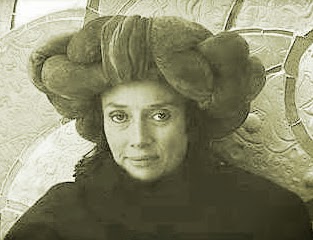Niki de Saint Phalle - Sculptor and Painter
"Catherine
Marie-Agnès de Saint Phalle" Born 1930 in France, her father was French, her
mother American, the second of five children from a wealthy family who lost
their fortune in the stock market collapse.
She spent most of her childhood and adolescence in New York, in an early display of her later artistic temperament, she paints the fig leaves of her convent school's classical sculptures red, she is transferred to a new school shortly after.
She spent most of her childhood and adolescence in New York, in an early display of her later artistic temperament, she paints the fig leaves of her convent school's classical sculptures red, she is transferred to a new school shortly after.
As a young woman
Niki's first career is as a fashion model, with photographs appearing in Vogue
and Life, at 18 she elopes with childhood friend Harry Mathews. In 1950, Niki
begins making her first paintings while her husband studies music at Harvard
University. Laura, their first child, is born in 1951. In 1952 she moves to Paris to study theatre and acting while Harry studies
music. In 1953 after being hospitalized for a nervous breakdown Niki finds that
painting helps her to overcome this crisis and decides to give up acting and
become an artist.
Following her recovery she briefly returns to Paris, where she is encouraged by other artists to continue painting in her unique self-taught style.
In Spain, Niki discovers the work of Antonio Gaudí and is deeply affected, especially by Park Güell in Barcelona, which plants the idea to create her own sculpture garden and inspires her to use diverse materials and found objects as essential elements in her art.
Following her recovery she briefly returns to Paris, where she is encouraged by other artists to continue painting in her unique self-taught style.
In Spain, Niki discovers the work of Antonio Gaudí and is deeply affected, especially by Park Güell in Barcelona, which plants the idea to create her own sculpture garden and inspires her to use diverse materials and found objects as essential elements in her art.
She is perhaps
best known for her "shooting
paintings" - complex assemblages with concealed paint
containers that are shot by pistol or rifle. The impact of the projectile
creates spontaneous effects which finish the work. The shooting paintings
evolve to include elements of spectacle and performance. Niki becomes part of
the Nouveau Réalisme group of artists, being the only woman in a group that
includes Arman, Christo, Yves Klein, Jean Tinguely, and Jacques de la Villeglé,
among others.
Niki has her first solo exhibition in Paris in 1961.
Niki has her first solo exhibition in Paris in 1961.
("I was shooting at myself and society
with its injustices. I was shooting at my own violence and the violence of the
times.")
After the "Shooting paintings"
came a period when she explored the various roles of woman, she made life size
dolls of women giving birth, usually dressed in white, they were primarily made
of polyester with a wire framework, generally created from papier mâché.
Inspired by the pregnancy of her friend
Clarice Rivers, the wife of American artist Larry Rivers, she began to use her
artwork to consider archetypal female figures in relation to her thinking on
the position of women in society. Her artistic expression of the proverbial
everywoman were named "Nanas". These large-scale, outrageous and
colourful sculptures have appeared in museums, advertisements and worldwide
exhibitions. (The word
"nana" is French for "dame" or "chick.")
Niki's first permanent architectural project was a private commission for a summer residence in the south of France, completed in 1971. She begins to develop other "fantastic" architectural projects that require intensive planning and organization. She travels to India and Egypt and the world over broadening the repertoire of cultural experiences and visual associations used in her work.
Niki's first permanent architectural project was a private commission for a summer residence in the south of France, completed in 1971. She begins to develop other "fantastic" architectural projects that require intensive planning and organization. She travels to India and Egypt and the world over broadening the repertoire of cultural experiences and visual associations used in her work.
Three of the large-scale Nanas situated in a permanent site near the
town hall in Hannover, Germany. The city named them Sophie, Charlotte, and
Caroline in honor of three historically distinguished queens of Hannover.
Her career as an
Artist continued until 2001 and involved sculpture, architecture and also
writing and illustrating a book ( AIDS: You Can't Catch It Holding Hands. )(
In collaboration with Dr. Silvio Barandun )
Her work is internationally acknowledged and accepted, she is one of the most and famous female artists of the 20th century and has been a major figure in contemporary art, vivacious, inventive, original and open minded.
Her work is internationally acknowledged and accepted, she is one of the most and famous female artists of the 20th century and has been a major figure in contemporary art, vivacious, inventive, original and open minded.
Niki de Saint Phalle died on May 21, 2002, at
the age of 71 in La Jolla, California.


No comments:
Post a Comment